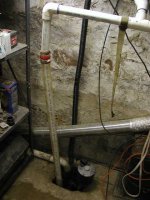Inspector507...thanks much for your input on the electrical code for sump pumps. I'm currently finishing off half our new basement which is 40X17 in size...the sump pit is located in one corner and thanks to you I know EXACTLY how to wire it up now.
While on the subject of sump pumps and water, I'd like to describe the situation that has existed in our new basement since it was built, in the hope someone may have an idea of what can be done to resolve our problem.
In mid-2002 we had an excavation dug in our back yard, the new foundation (blocks) was sized 36X40. The deepest part of the excavation was just under 7 feet below grade, and the house we added onto was located on the highest point of our property, and the back yard where the new basement was constructed sloped away from the house. When we dug another half foot down to build the footing forms, we started getting water seepage in the northeast corner. This was in the middle of a very dry summer...and because of the water seepage, we triple sized the footing in that corner and located the sump pit there. The foundation was waterproofed well and the drain tile covered with the usual peastone and filter fabric, and instead of backfilling the exterior of the foundation with the pure clay that was excavated, we used fill sand and gravel instead.
I've done everything I possibly can to divert water away from the house with gutters and long downspouts, built up the ground with topsoil, then covered the topsoil with heavy plastic and peastone to shed water away...but whenever there is a heavy rainfall or snow melting, the sump pit has an inflow of 5 to 6 gpm. We had an 8 inch thick snow melting a few days ago and then a heavy rainfall following that, the sump pump was turning on every 3 minutes for three days straight...I run the exterior drain pipe from the pump up about 5 feet then thru the wall and 100 feet away from the house.
When the excavation was done and before the blocks were laid I checked carefully around the exterior of the hole to see if I could locate any old pipes that might indicate a former well and/or septic tank drainfield that might be backfeeding that corner...no such thing existed. There was originally a huge 2 story brick and fieldstone farmhouse where our new addition is located and it burnt down in 1949...which is why I made the search for old pipes.
Would anyone have some ideas of what would be causing all this water intake, or have some ideas of what could be done to cure the problem? I currently have a brand new sump pump, a backup pump, and a genset, but I am still concerned about what could happen, especially if we were away and something went wrong.
Sorry if I bored anyone with this long winded post...and thanks.


